August 24, 2011
Harry's Life
There are times that I hate blogging. Trying to come up with interesting posts, spending the time to bring them to fruition, then realizing that it was an "eh" idea in the first place. Then there are the days that you can't come up with anything good at all, and you resort to posting pictures of rubber duckies or cartoon girls or music videos. There are days where you just feel like chucking it all and walking away.
And then there's days like today, when the perfect idea for a story falls into your lap. Like this one, which I'll call "Harry's Life."
Harry lived and worked in India before The War To End All Wars. A newspaper reporter, he surely could smell the coming conflict, but he was of the age where one has no fear of one's own mortality. It could never happen to you, it would always happen to the other guy. Once the Great Mistake (pt 1) began, Harry didn't give staying out of the fray a second thought.
Harry was never a tall man. He did have the air of the rake about him, however, with hair that Clark Gable could only envy. He occasionally grew a dapper mustache, but it never stayed around for long. His eyes had the cool, appraising look that were the mark of a good newspaperman. In truth, he didn't look the part of a soldier but when War began, he immediately enlisted with the nearest British regiment... well, almost. Instead, he joined the Ghurkas.
"If a man says he is not afraid of dying, he is either lying or a Ghurka." This quote, from Field Marshal Manekshaw, tells you all that you need to know about the fighting spirit of these legendary soldiers. Amongst them, Harry felt at home. He learned and truly understood the war cry of the Ghurkas, "Jai Mahakali, Ayo Gorkhali!", which translates to "Glory be to the Goddess of War, here come the Ghurkas!" When his regiment was called to France, Harry went along... to the Battle of Loos.
In a war full of mass casualties for little gain, Loos would barely rate a mention... if it wasn't for the futility of it all. Ammunition shortages limited the pre-attack artillery bombardment. The British used poison gas for the first time, releasing 140 tons of chlorine gas... much of which was blown back over their own lines. Then, at 0630 on September 29th, 1915, six divisions of troops charged out of their trenches... into the face of German machinegunners unfazed by the weak bombardment. As they charged across the open plain between the trenchlines, the Ghurkas discovered that much of the German barbed wire was still in place, unsevered by artillery. Undaunted, Harry found himself in the forefront of his company's charge into the enemy trenches. With kukri and grenade, he helped cause one of the first substantial breakthroughs of the war, leading to the taking of the town of Loos. Three days later, the Germans counterattacked and threw the British back to their lines. Over 20000 men lay wounded or dead after three days of stiff fighting. Harry was one of them, the victim of a German artillery shell.
Riddled with shrapnel, he was invalided to England to recuperate. While there, his Regiment of Ghurkas, used up by battle, was sent back to India, surely kicking and screaming. However, Harry wasn't done with France yet. Once up and around, he joined The Duke of Cambridge's Own Middlesex Regiment and returned to the trenches. Except this time around, he was an oddity. His kukri by his side, he knew his ways around the muddy passages and the fields of death around him. His experience made him valuable to his company, and he quickly became a trusted squad leader. One dark night, he led a handpicked team across no-man's land, returning with prisoners and intelligence. This brazen mission earned him a mention in the regimental dispatches... and a Croix de Guerre with bronze star. He only just was told of this honor when his old nemesis, the German artillery shell, found him again and left him with a bellyful of shrapnel. And back to England he was sent once again, back to hospital.
While there, he caught the eye of a pretty nurse. Certainly there wasn't a whole lot he could do with his abdomen wrapped in bandages, but his good looks and witty repartee certainly stood out amongst the other soldiers there. In some ways, leaving hospital was one of the tougher things he'd ever done... after all, he was leaving the pretty nurse behind. Much to his surprise and delight, she made sure he knew how and where to reach her when he could. For once again, the warrior in Harry sent him back into the fray. But this time, he would make sure that the German artillery could not get him.
As early as his time at Loos, Harry would look up and see the birds of the Royal Flying Corps soaring high above him and marvel at their grace and serenity. During his second recuperation, he petitioned for a transfer to the RFC, and to everybody's amazement, he was accepted. Perhaps 'Bloody April' had something to do with it. In any case, Harry found himself posted to RAF Station Marham, flying the Sopwith 1-1/2 Strutter. Perhaps unsurprisingly, he tended to fly the way a Ghurka fights... take no prisoners and all-out, nearly in a frenzy. Also perhaps unsurprisingly, in 1917 he somehow managed to make his bus fall eight hundred feet out of the sky and into a cabbage field. The result looked something like this...
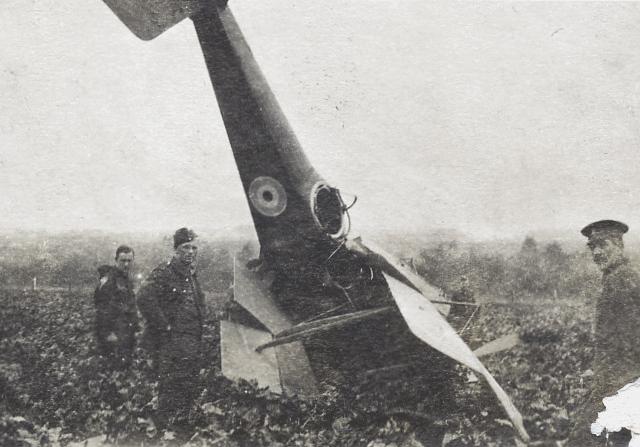
His training set back by the injuries sustained by this wreck, he only managed to fly a few milk-run missions over France before the war came to an end. One would think that'd be the end of the tale of Harry's life, but in some ways the best was yet to come.
After the war, Harry tracked down the pretty nurse, courted her and eventually married her. Amongst other things, he somehow eneded up working for St Dunstan's, the UK's national charity for ex-servicemen that had suffered blindness due to the war. There, he taught various vocational skills and discovered that he himself had a hidden skill at laquerwork. Late in his life, Her Majesty Queen Elizabeth II came to St Dunstan's, where he presented her with one of his laquerwork trays in celebration of her visit. It was one of the high points of a busy, and unique, life.
A wonderful story, and I'm glad I came up with it... except I left out two details which make it even more amazing:
more...
And then there's days like today, when the perfect idea for a story falls into your lap. Like this one, which I'll call "Harry's Life."
Harry lived and worked in India before The War To End All Wars. A newspaper reporter, he surely could smell the coming conflict, but he was of the age where one has no fear of one's own mortality. It could never happen to you, it would always happen to the other guy. Once the Great Mistake (pt 1) began, Harry didn't give staying out of the fray a second thought.
Harry was never a tall man. He did have the air of the rake about him, however, with hair that Clark Gable could only envy. He occasionally grew a dapper mustache, but it never stayed around for long. His eyes had the cool, appraising look that were the mark of a good newspaperman. In truth, he didn't look the part of a soldier but when War began, he immediately enlisted with the nearest British regiment... well, almost. Instead, he joined the Ghurkas.
"If a man says he is not afraid of dying, he is either lying or a Ghurka." This quote, from Field Marshal Manekshaw, tells you all that you need to know about the fighting spirit of these legendary soldiers. Amongst them, Harry felt at home. He learned and truly understood the war cry of the Ghurkas, "Jai Mahakali, Ayo Gorkhali!", which translates to "Glory be to the Goddess of War, here come the Ghurkas!" When his regiment was called to France, Harry went along... to the Battle of Loos.
In a war full of mass casualties for little gain, Loos would barely rate a mention... if it wasn't for the futility of it all. Ammunition shortages limited the pre-attack artillery bombardment. The British used poison gas for the first time, releasing 140 tons of chlorine gas... much of which was blown back over their own lines. Then, at 0630 on September 29th, 1915, six divisions of troops charged out of their trenches... into the face of German machinegunners unfazed by the weak bombardment. As they charged across the open plain between the trenchlines, the Ghurkas discovered that much of the German barbed wire was still in place, unsevered by artillery. Undaunted, Harry found himself in the forefront of his company's charge into the enemy trenches. With kukri and grenade, he helped cause one of the first substantial breakthroughs of the war, leading to the taking of the town of Loos. Three days later, the Germans counterattacked and threw the British back to their lines. Over 20000 men lay wounded or dead after three days of stiff fighting. Harry was one of them, the victim of a German artillery shell.
Riddled with shrapnel, he was invalided to England to recuperate. While there, his Regiment of Ghurkas, used up by battle, was sent back to India, surely kicking and screaming. However, Harry wasn't done with France yet. Once up and around, he joined The Duke of Cambridge's Own Middlesex Regiment and returned to the trenches. Except this time around, he was an oddity. His kukri by his side, he knew his ways around the muddy passages and the fields of death around him. His experience made him valuable to his company, and he quickly became a trusted squad leader. One dark night, he led a handpicked team across no-man's land, returning with prisoners and intelligence. This brazen mission earned him a mention in the regimental dispatches... and a Croix de Guerre with bronze star. He only just was told of this honor when his old nemesis, the German artillery shell, found him again and left him with a bellyful of shrapnel. And back to England he was sent once again, back to hospital.
While there, he caught the eye of a pretty nurse. Certainly there wasn't a whole lot he could do with his abdomen wrapped in bandages, but his good looks and witty repartee certainly stood out amongst the other soldiers there. In some ways, leaving hospital was one of the tougher things he'd ever done... after all, he was leaving the pretty nurse behind. Much to his surprise and delight, she made sure he knew how and where to reach her when he could. For once again, the warrior in Harry sent him back into the fray. But this time, he would make sure that the German artillery could not get him.
As early as his time at Loos, Harry would look up and see the birds of the Royal Flying Corps soaring high above him and marvel at their grace and serenity. During his second recuperation, he petitioned for a transfer to the RFC, and to everybody's amazement, he was accepted. Perhaps 'Bloody April' had something to do with it. In any case, Harry found himself posted to RAF Station Marham, flying the Sopwith 1-1/2 Strutter. Perhaps unsurprisingly, he tended to fly the way a Ghurka fights... take no prisoners and all-out, nearly in a frenzy. Also perhaps unsurprisingly, in 1917 he somehow managed to make his bus fall eight hundred feet out of the sky and into a cabbage field. The result looked something like this...

His training set back by the injuries sustained by this wreck, he only managed to fly a few milk-run missions over France before the war came to an end. One would think that'd be the end of the tale of Harry's life, but in some ways the best was yet to come.
After the war, Harry tracked down the pretty nurse, courted her and eventually married her. Amongst other things, he somehow eneded up working for St Dunstan's, the UK's national charity for ex-servicemen that had suffered blindness due to the war. There, he taught various vocational skills and discovered that he himself had a hidden skill at laquerwork. Late in his life, Her Majesty Queen Elizabeth II came to St Dunstan's, where he presented her with one of his laquerwork trays in celebration of her visit. It was one of the high points of a busy, and unique, life.
A wonderful story, and I'm glad I came up with it... except I left out two details which make it even more amazing:
more...
Posted by: Wonderduck at
10:56 PM
| Comments (2)
| Add Comment
Post contains 1351 words, total size 8 kb.
August 14, 2011
August 14, 1945
66 years ago today, Japan surrendered to the Allies, thus bringing an end to World War II. The official ceremony wasn't conducted until September 2nd, and that's the day that we celebrate here in the US as the end of hostilities, August 14th was the date that the the announcement was made to the Japanese people. August 14th was also the date the second-most famous photograph from the Pacific War was taken.
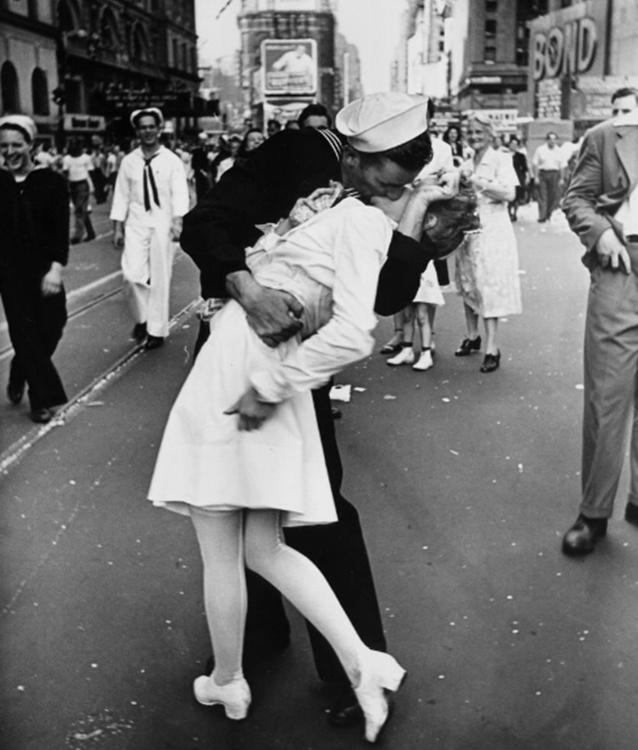
I wonder what the following 19 days were like for those on the front lines of the war. Hostilities had ended, but it wasn't official yet... and surely nobody wanted to be the last casualty of WWII.

I wonder what the following 19 days were like for those on the front lines of the war. Hostilities had ended, but it wasn't official yet... and surely nobody wanted to be the last casualty of WWII.
Posted by: Wonderduck at
09:18 PM
| Comments (6)
| Add Comment
Post contains 112 words, total size 1 kb.
August 09, 2011
The Muroc Maru
Over the years, practice targets have taken many forms. Watermelons, poles stuck in the ground, human silhouettes, bulls-eyes, "black dots," on and on. One of the most... unique... was finished in 1943.
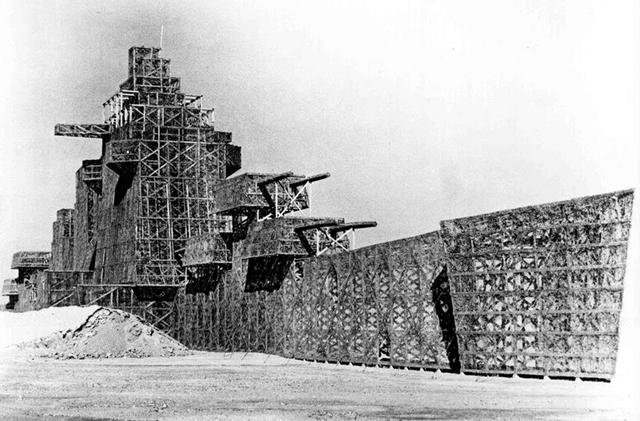
Army Air Forces Temporary Building (Target) T-799, dubbed the "Muroc Maru", was constructed on the grounds of Muroc AAF Base for the then princely sum of $35000. Built out of 4x4 lumber and chicken wire, then covered with tar paper and liberally coated with ground-up chicken feathers, it was the spitting image of an Imperial Japanese Navy Takao-class heavy cruiser. Sand berms were added to give the appearance of a wake.
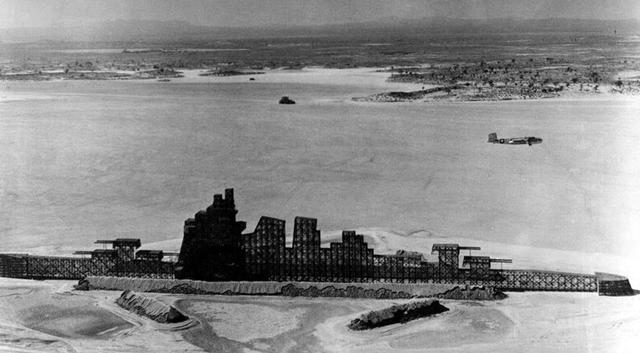
Probably the largest single-structure target ever built at 650 feet long, the Muroc Maru was used for identification training, strafing and skip-bombing practice. Unfortunately, the chicken feathers could not hold up to the hot winds and .50cal slugs and usually disintegrated or blew away.

Built at one end of Rogers Dry Lake on the Muroc base complex, it often gave pilots the impression of movement from heat distortion coming off the lakebed. It also caused some consternation amongst drivers passing by to the north, to whom it looked exactly like a ship sailing in the desert.
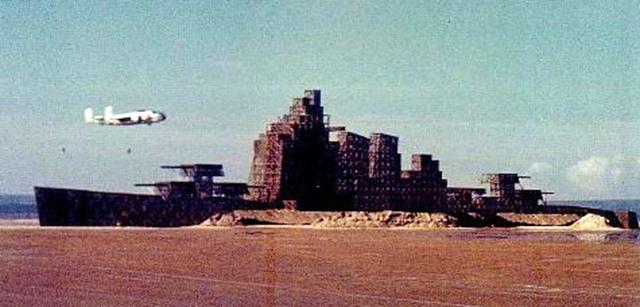
The Muroc Maru stayed in position until 1950, when it was declared a flight hazard and taken down (sunk?). Reportedly the Army engineers had quite the time of it from all the unexploded ordinance in the vicinity. All that remains today are a few tons worth of nails and staples and some sand berms.

Army Air Forces Temporary Building (Target) T-799, dubbed the "Muroc Maru", was constructed on the grounds of Muroc AAF Base for the then princely sum of $35000. Built out of 4x4 lumber and chicken wire, then covered with tar paper and liberally coated with ground-up chicken feathers, it was the spitting image of an Imperial Japanese Navy Takao-class heavy cruiser. Sand berms were added to give the appearance of a wake.

Probably the largest single-structure target ever built at 650 feet long, the Muroc Maru was used for identification training, strafing and skip-bombing practice. Unfortunately, the chicken feathers could not hold up to the hot winds and .50cal slugs and usually disintegrated or blew away.

Built at one end of Rogers Dry Lake on the Muroc base complex, it often gave pilots the impression of movement from heat distortion coming off the lakebed. It also caused some consternation amongst drivers passing by to the north, to whom it looked exactly like a ship sailing in the desert.

The Muroc Maru stayed in position until 1950, when it was declared a flight hazard and taken down (sunk?). Reportedly the Army engineers had quite the time of it from all the unexploded ordinance in the vicinity. All that remains today are a few tons worth of nails and staples and some sand berms.
Posted by: Wonderduck at
06:40 PM
| Comments (5)
| Add Comment
Post contains 256 words, total size 2 kb.
August 08, 2011
Name This Mystery Ship VII
Interesting one for y'all tonight...

Take a guess, get it right, win a post!

Take a guess, get it right, win a post!
Posted by: Wonderduck at
09:41 PM
| Comments (15)
| Add Comment
Post contains 19 words, total size 1 kb.
August 07, 2011
The Other Zero
Whenever a nation has more than one branch of its military, something of a cordial disliking will invariably spring up between them. For example, here in the US the Army doesn't much care for the Navy, the Navy has a mild distaste for the Army, and nobody likes the Marines. When it comes right down to it however, all three know they've got to work together and when the time comes, they set aside their rivalries and land on their enemies like a ton of bricks.
And then there was the Imperial Japanese military in World War II. The Army and the Navy didn't cordially dislike each other, they flat out hated each other. Each had their own plans on how to conduct the war and only deviated from them when they needed something from the other. The only reason you couldn't say that, say, the IJN's main enemy was the IJA was that the two services didn't openly shoot at each other. This open distaste extended to the designs of each forces' aircraft. While the US Army Air Forces and the US Navy designed planes that were radically different, that's because each service had different requirements. Strangely, the requirements for the IJN and the IJA were pretty much identical, save for the need for Navy planes to land on a carrier.
Both the Navy and the Army needed replacements for their front-line fighers, the A5M (Claude) and the Ki-27 (Nate), two very similar designs. Mitsubishi won the design contract for the Navy with the A6M, the famous Zero. Nakajima's design for the replacement of their own Ki-27 was the Ki-43 Hayabusa.
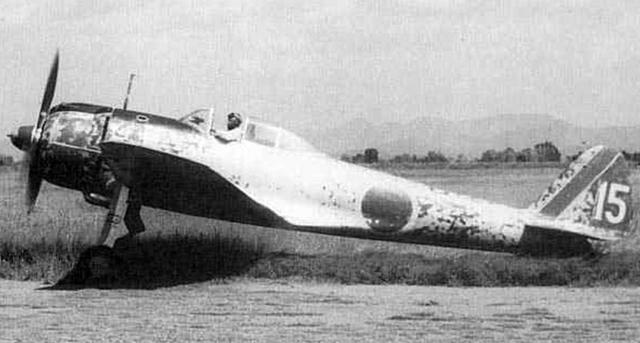
To say that there was a resemblance to the Zero would be something of an understatement. Both fighters used the same Sakae radial engine, at least to begin with. Both were slim, with slightly bent cantilevered wings. However, the Zero was nearly 700lbs heavier at all-up weight. This made the Hayabusa (Allied code name "Oscar") even more maneuverable than the already outstandingly nimble Zero.
Unlike the Zero, which passed its initial flight tests with ease, the Hayabusa was something of a dog right off the drawing table. In fact, the plane was nearly rejected on the grounds of being rather UNmaneuverable. Over the course of ten preproduction aircraft, the Oscar was modified with a larger wing, had its weight cut, and finally had a set of butterfly (or "combat") flaps installed. This proved to be the fix the fighter needed, and it was ordered into mass production.
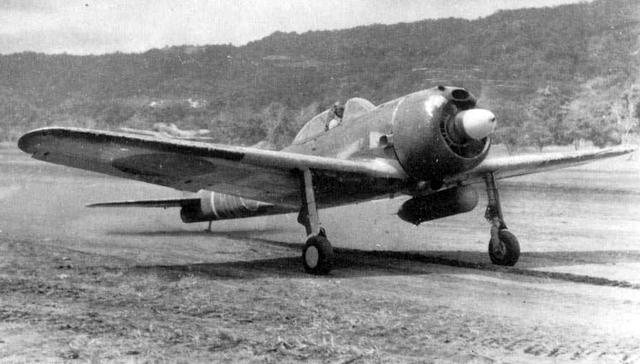
One can safely assume that the main weight difference between the Zero and the Hayabusa was that the latter did not need the sort of structural strength a plane requires to land on an aircraft carrier. One drawback of this was that the Zero, which was never what one would call a sturdy aircraft, was by comparison to the Hayabusa carved out of a single block of iron. Another way the Hayabusa saved weight was in the form of weaponry. For most of the war, the Ki-43 carried only a pair of 7.7mm machine guns, the exact same armament as a Sopwith Camel from World War I.
At the beginning of the Pacific War though, this was enough. In combat, the Hayabusa was nearly as successful as the Zero. Being able to outturn and outclimb anything in the skies, once an Oscar got on a plane's tail, it could pretty much stay there at will. It was only a tiny bit slower than a Zero as well. All of this meant that it was a dangerous package. It even had some armor for the pilot and rudimentary self-sealing fuel tanks to boot.
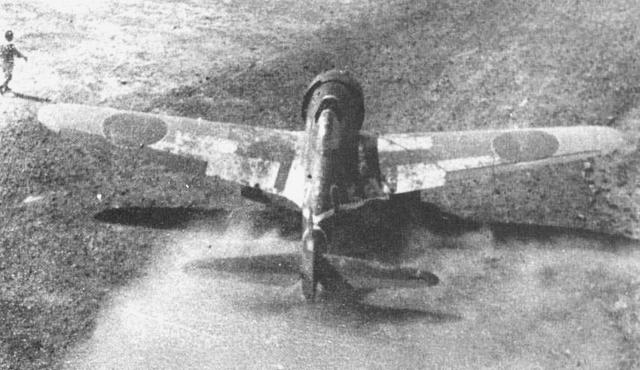
The Hayabusa's main weakness was that it was ridiculously fragile. While less prone to catching fire like the Zero, it tended to come apart under Allied gunfire. Indeed, hits that even a Zero could shrug off were often enough to cause the Ki-43 to shatter like porcelain. The hard part was landing a blow on the nimble little plane in the first place.
Upgrades were applied to the Ki-43 over the course of the war. First, a larger engine was installed that gave better performance at high altitudes, then the guns were upgraded to 12.7mm. However, these upgrades were never going to be enough to keep up with newer Allied planes like the Hellcat, Corsair or Seafire. Replaced by the Ki-44 (Tojo) and Ki-61 (Tony), it was never entirely phased out and stayed in front-line service for the entire war. As with most other Japanese planes, it ended the war in a Kamikaze role, but not until nearly 6000 were built, making it the second-most popular Japanese fighter... behind only the Zero. Every IJA ace got the majority of his kills in the Oscar, and one source in my collection even claims that the Ki-43 was responsible for shooting down more Allied planes than the Zero. Not a bad record for a fragile, slow, undergunned fighter that was overshadowed by the A6M.
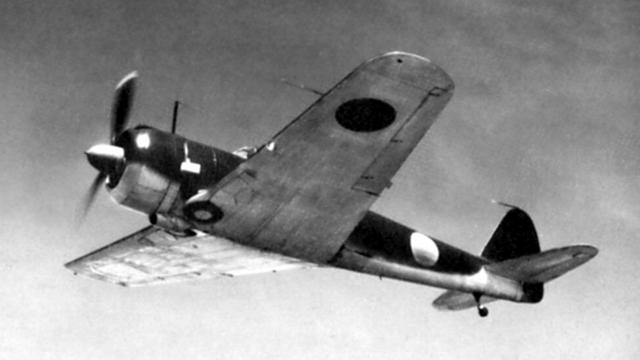
Today, only six Ki-43s are known to exist, and only one of those is in flyable condition.
And then there was the Imperial Japanese military in World War II. The Army and the Navy didn't cordially dislike each other, they flat out hated each other. Each had their own plans on how to conduct the war and only deviated from them when they needed something from the other. The only reason you couldn't say that, say, the IJN's main enemy was the IJA was that the two services didn't openly shoot at each other. This open distaste extended to the designs of each forces' aircraft. While the US Army Air Forces and the US Navy designed planes that were radically different, that's because each service had different requirements. Strangely, the requirements for the IJN and the IJA were pretty much identical, save for the need for Navy planes to land on a carrier.
Both the Navy and the Army needed replacements for their front-line fighers, the A5M (Claude) and the Ki-27 (Nate), two very similar designs. Mitsubishi won the design contract for the Navy with the A6M, the famous Zero. Nakajima's design for the replacement of their own Ki-27 was the Ki-43 Hayabusa.

To say that there was a resemblance to the Zero would be something of an understatement. Both fighters used the same Sakae radial engine, at least to begin with. Both were slim, with slightly bent cantilevered wings. However, the Zero was nearly 700lbs heavier at all-up weight. This made the Hayabusa (Allied code name "Oscar") even more maneuverable than the already outstandingly nimble Zero.
Unlike the Zero, which passed its initial flight tests with ease, the Hayabusa was something of a dog right off the drawing table. In fact, the plane was nearly rejected on the grounds of being rather UNmaneuverable. Over the course of ten preproduction aircraft, the Oscar was modified with a larger wing, had its weight cut, and finally had a set of butterfly (or "combat") flaps installed. This proved to be the fix the fighter needed, and it was ordered into mass production.

One can safely assume that the main weight difference between the Zero and the Hayabusa was that the latter did not need the sort of structural strength a plane requires to land on an aircraft carrier. One drawback of this was that the Zero, which was never what one would call a sturdy aircraft, was by comparison to the Hayabusa carved out of a single block of iron. Another way the Hayabusa saved weight was in the form of weaponry. For most of the war, the Ki-43 carried only a pair of 7.7mm machine guns, the exact same armament as a Sopwith Camel from World War I.
At the beginning of the Pacific War though, this was enough. In combat, the Hayabusa was nearly as successful as the Zero. Being able to outturn and outclimb anything in the skies, once an Oscar got on a plane's tail, it could pretty much stay there at will. It was only a tiny bit slower than a Zero as well. All of this meant that it was a dangerous package. It even had some armor for the pilot and rudimentary self-sealing fuel tanks to boot.

The Hayabusa's main weakness was that it was ridiculously fragile. While less prone to catching fire like the Zero, it tended to come apart under Allied gunfire. Indeed, hits that even a Zero could shrug off were often enough to cause the Ki-43 to shatter like porcelain. The hard part was landing a blow on the nimble little plane in the first place.
Upgrades were applied to the Ki-43 over the course of the war. First, a larger engine was installed that gave better performance at high altitudes, then the guns were upgraded to 12.7mm. However, these upgrades were never going to be enough to keep up with newer Allied planes like the Hellcat, Corsair or Seafire. Replaced by the Ki-44 (Tojo) and Ki-61 (Tony), it was never entirely phased out and stayed in front-line service for the entire war. As with most other Japanese planes, it ended the war in a Kamikaze role, but not until nearly 6000 were built, making it the second-most popular Japanese fighter... behind only the Zero. Every IJA ace got the majority of his kills in the Oscar, and one source in my collection even claims that the Ki-43 was responsible for shooting down more Allied planes than the Zero. Not a bad record for a fragile, slow, undergunned fighter that was overshadowed by the A6M.

Today, only six Ki-43s are known to exist, and only one of those is in flyable condition.
Posted by: Wonderduck at
09:39 PM
| Comments (2)
| Add Comment
Post contains 853 words, total size 5 kb.
<< Page 1 of 1 >>
52kb generated in CPU 0.0107, elapsed 0.0279 seconds.
25 queries taking 0.0208 seconds, 69 records returned.
Powered by Minx 1.1.6c-pink.
25 queries taking 0.0208 seconds, 69 records returned.
Powered by Minx 1.1.6c-pink.









